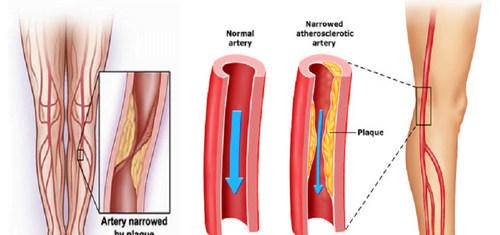The PAD is a shortcut which is used for peripheral artery disease and it is also called peripheral arterial disease. This is a very common circulatory problem and in this condition the narrowed arteries are reducing the blood flow to the limbs. When someone develops peripheral artery disease, then his extremities (which is usually his legs) are not receiving enough blood flow to keep up with the demand. This is causing symptoms which in the most cases is a leg pain while walking (it is known as a claudication). This disease can be a sign of a more widespread accumulation of fatty deposits in arteries (this condition is known as atherosclerosis). It is known that this condition can reduce the blood flow to your brain and heart as well as your legs. In many cases, this condition can be successfully treated when you are eating a healthy diet, exercising and quitting tobacco.

Peripheral artery disease symptoms
Contents
There are many people who suffer from peripheral artery disease who have mild or no symptoms but there are some people who can have leg pain while they are walking. This leg pain is known as claudication. The symptoms of claudication are including cramping in your legs or arms or muscle pain that are triggered by activity, such as walking but these symptoms disappear after a few minutes of a rest. The location of your pain will depend on the location of your narrowed or clogged artery. The most common location is the calf pain. The severity of the claudication can vary a lot, from mild discomfort to a debilitating pain. If you have severe claudication, then it can be hard for you to walk or to do other types of physical activity. Here are the symptoms of peripheral artery disease:
- Erectile dysfunction in men
- No pulse or a weak pulse in your legs or feet
- Shiny skin on your legs
- Slower growth of your toenails
- Hair loss or slower hair growth on your feet and legs
- A change in the color of your legs
- Sores on your toes, feet or legs that won’t heal
- Coldness in your lower leg or foot, especially when compared with other side
- Leg numbness or weakness
- There are many people who have a painful cramping which is located in your thigh or calf muscles or hip after certain activities, such as walking or climbing stairs (claudication)
If this condition progresses, then the pain can happen even when you are resting or when you are lying down (it is known as ischemic rest pain). This pain can be intense enough to disrupt your sleep. Walking around your room or hanging your legs over the edge of your bed can give you a temporary relief from the pain.
Peripheral artery disease causes
This condition in many cases is caused by atherosclerosis. When someone has atherosclerosis, then fatty deposits (also known as plaques) are building up in your artery walls and they can reduce your blood flow. When we talk about atherosclerosis, then the heart is the focus of discussion but when someone has peripheral artery disease then arteries throughout your body are affected. When the atherosclerosis is happening in the arteries which are supplying the blood to your limbs, then it causes peripheral artery disease. In less common cases, the cause for the peripheral artery disease can be radiation exposure, unusual anatomy of your ligaments or muscles, injury to your limbs and blood vessel inflammation.
Peripheral artery disease risk factors
Below we are giving some factors which can increase your risk of developing peripheral artery disease:
- High levels of homocysteine, a protein component which helps build and maintain tissue
- A family history of peripheral artery disease, stroke or heart attack
- Increasing age, especially after reaching 50 years of age
- High cholesterol
- High blood pressure
- Obesity (a body mass index over 30)
- Diabetes
- Smoking
Those people who have diabetes or who smoke have increased risk of developing peripheral artery disease because they have reduced blood flow.
Complications
You should know that if the peripheral artery disease is caused by a buildup of plaques in the blood vessels, then you have increased risk of developing:
- Stroke and heart attack: The atherosclerosis which is causing signs and symptoms of peripheral artery disease is not just limited to your legs. The fat deposits are also building up in the arteries that are supplying your brain and heart.
- Critical limb ischemia: This condition is beginning as an open sore which does not heal, an infection or an injury of your legs and feet. This condition is happening when these infections or injuries are progressing and they cause tissue death.




